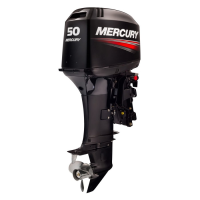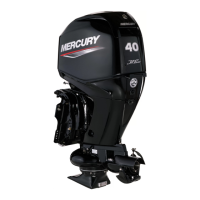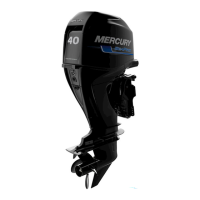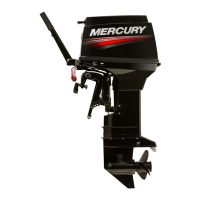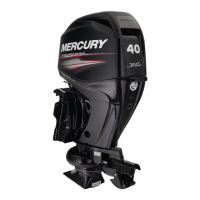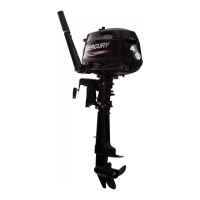MAINTENANCE
47
AFTER EACH USE
• Flush out the outboard cooling system if operating in salt or polluted water. See Flushing the
Cooling System.
• Wash off all salt deposits and flush out the exhaust outlet of the propeller and gearcase with fresh
water if operating in salt water.
EVERY 100 HOURS OF USE OR ONCE YEARLY, WHICHEVER OCCURS
FIRST
• Lubricate all lubrication points. Lubricate more frequently when used in salt water. See Lubrication
Points.
• Change engine oil and replace the oil filter. The oil should be changed more often when the engine
is operated under adverse conditions such as extended trolling. See Changing Engine Oil.
• Inspect thermostat visually for corrosion and broken spring. Make sure thermostat closes
completely at room temperature.
1.
• Check engine fuel filter for contaminants. See Fuel System.
•
Check engine timing setup.
1.
• Check corrosion control anodes. Check more frequently when used in salt water. See Corrosion
Control Anodes.
• Drain and replace gearcase lubricant. See Gearcase Lubrication.
•
Lubricate splines on the driveshaft.
1.
• Check power trim fluid. See Checking Power Trim Fluid.
• Inspect battery. See Battery Inspection.
•
Check control cable adjustments.
1.
• Inspect timing belt. See Timing Belt Inspection.
• Check tightness of bolts, nuts, and other fasteners.
• Check cowl seals to make sure seals are intact and not damaged.
• Check internal cowl sound reduction foam (if equipped) to make sure foam is intact and not
damaged.
• Check that the intake silencer (if equipped) is in place.
• Check that the idle relief muffler (if equipped) is in place.
• Check for loose hose clamps and rubber boots (if equipped) on the air intake assembly.
EVERY 300 HOURS OF USE OR THREE YEARS
• Replace spark plugs at first 300 hours or third year. After that, inspect spark plugs every 300
hours or three years. Replace spark plugs as needed. See Spark Plug Inspection and
Replacement.
• Replace water pump impeller (more often if overheating occurs or reduced water pressure is
noted).
1.
•
Check and adjust valve clearance, if necessary.
1.
BEFORE PERIODS OF STORAGE
• Refer to Storage procedure. See Storage section.
Flushing the Cooling System
Flush the internal water passages of the outboard with fresh water after each use in salt, polluted, or
muddy water. This will help prevent a buildup of deposits from clogging the internal water passages.
IMPORTANT: The engine must be run during flushing in order to open the thermostat and circulate water
through the water passages.
1. These items should be serviced by an authorized dealer.
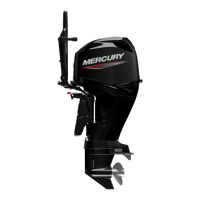
